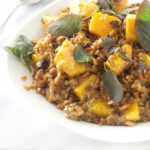Butternut Squash Farro Risotto
This butternut squash farro risotto has it all…..texture from the tender grains, sweetness from the cubes of squash, creaminess from the crème fraîche and cheese, plus the ever-so-slight flavors of fresh sage and seasonings.
Servings: 6 servings
Ingredients
For the Squash:
- 10 ounces peeled butternut squash cut into 1-inch cubes
- 2 tablespoons olive oil
- ½ teaspoon salt
- ¼ teaspoon freshly ground pepper
For the Farro Risotto:
- 2 strips lean smokey bacon diced
- 1 medium shallot peeled and finely chopped
- 2 garlic cloves finely chopped
- 2 tablespoons chopped fresh sage leaves
- 1 cup farro whole grains or pearled farro
- 1 tablespoon butter
- 1 cup white wine
- 5 cups chicken or beef broth
- 1 cup crème fraîche or heavy cream
- 1 tablespoon olive oil
- few grindings of nutmeg
- 4 ounces Fontina cheese grated (about 1 cup) plus more for serving
- 1 ounce Parmesan cheese grated (about 1/4 cup)
For the Garnish:
- ½ cup fresh sage leaves
- Grape seed coconut or avocado oil to fry the sage leaves
Instructions
Roast the Butternut Squash
- Preheat the oven to 400°F
- In a large bowl, add the butternut cubes and toss with the olive oil. Spread the cubes on a sheet pan and sprinkle with salt and pepper.
- Transfer to the oven and roast for 20 minutes or until the butternut squash is tender. Remove from the oven and set aside to cool
For the Farro Risotto
- In a large, deep skillet (5 to 6 quart capacity) add the diced bacon and cook for 4-6 minutes or until crispy. Transfer the bacon to a plate. Pour off all but 1 tablespoon of bacon fat in the skillet. Add the shallots and garlic. Season with salt and pepper.
- Add the butter to the skillet and melt it over medium heat. Once the butter melts, add the farro and cook, stirring occasionally, until the grains begin to pop and brown lightly. It will take about 5 to 6 minutes, and they will release a pleasant fragrance.
- Add the white wine and cook for 1 to 2 minutes. Pour in the chicken broth and bring the pot to a boil. Reduce the heat to a simmer (you should see gentle bubbles) and cover with a lid. Cook until the farro grains are easy to bite when tested and the liquid is absorbed. About 50-60 minutes (or 35 to 40 minutes if using pearled farro). They should have the texture of al dente pasta.
- Stir the crème fraîche into the risotto, and add the reserved squash and bacon. Stir in the gratings of nutmeg and taste, adjusting the salt and pepper if necessary.
- Add the grated Fontina cheese, Parmesan cheese, and olive oil. Fold gently, allowing the cheese to melt. Cover the pot and reserve.
For the Fried Sage Leaves:
- Pat the sage leaves dry with a paper towel. Add enough oil to cover the bottom of a small skillet set over medium heat. When the oil is hot, carefully add 4 to 5 sage leaves to the oil. They will sputter and spit when they hit the hot oil.
- Cook the leaves until they are crisp and slightly brown. If the oil is hot enough this should only take 30 to 40 seconds. Transfer the leaves to a paper-towel-lined plate. When all the leaves are cooked, sprinkle them with a pinch of salt while they are still warm.
- To serve the butternut farrotto, spoon it into a serving dish or individual plates. Add freshly grated Fontina cheese and crumble a few crisp sage leaves on top. Add additional crisp sage leaves as a garnish and serve.
Notes
- You can use any winter squash, such as butternut squash or red Kuri. You can also use sweet potatoes which will make this recipe a year-round favorite.
- Toasting the farro brings out the nutty flavors and more complexity in the whole grain.
- Farro is labeled a few different ways in the store. Sometimes it is simply called farro. However, it is also called emmer, einkorn, or spelt. All three grains are types of farro.
- Make sure the sage leaves do not have any moisture on them before you drop them in the hot oil. Fresh leaves naturally have some moisture inside them and they will sputter and crackle as soon as you put them in the oil. Freshly picked leaves will sputter even more than leaves that have been sitting out for a couple of days. Be careful to avoid hot oil from sputtering on your hands.
Nutrition
Serving: 1 | Calories: 258kcal | Carbohydrates: 24g | Protein: 19g | Fat: 54g | Saturated Fat: 25g | Polyunsaturated Fat: 25g | Trans Fat: 1g | Cholesterol: 201mg | Sodium: 722mg | Fiber: 4g | Sugar: 10g
